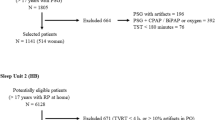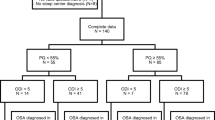Abstract
Purpose
Obstructive sleep apnea (OSA) is a common condition characterized by repetitive collapse of the upper airways and intermittent oxygen desaturation, which may lead to airway inflammation. Here, we explored whether fractional exhaled nitric oxide (FeNO) levels provide a non-invasive screening tool of OSA.
Methods
Over a 3-month period, FeNO levels were measured in consecutive non-smoking patients referred for a sleep laboratory. All patients underwent full polysomnography. OSA severity was classified based on the apnea/hypopnea index: ≥ 5.0/h as any OSA, ≥ 15.0/h as moderate/severe OSA, and ≥ 30.0/h as severe OSA. FeNO was measured by a portable device (NIOX-MINO®; Aerocrine AB, Solna, Sweden) and expressed as parts per billion (ppb). Discrimination by area under the curve (AUC) and binary logistic regression were performed.
Results
A total of 229 subjects were evaluated. Mean FeNO values were similar among subjects without OSA or with OSA: 16.9 ± 10.6 ppb versus 20.2 ± 14.5 ppb, p = 0.221; respectively. FeNO was not an inclusionary parameter to predict any OSA, moderate/severe OSA, and severe OSA: odds ratio (OR) 1.023 (95% confidence interval [CI]: 0.986–1.062); OR 1.012 (95% CI: 0.991–1.034); and OR 0.999 (95% CI: 0.980–1.018), respectively. The AUC values for FeNO in the diagnosis of any OSA, moderate/severe OSA, and severe OSA showed no discriminatory properties: AUC: 0.567 (95% CI: 0.464–0.670), AUC: 0.541 (95% CI: 0.465–0.618), and AUC: 0.535 (95% CI: 0.459–0.610); respectively.
Conclusions
In a sleep-lab setting, our findings suggest that FeNO measurements are inconsequential in the screening of OSA in adults.



Similar content being viewed by others
References
Peppard PE, Young T, Barnet JH, Palta M, Hagen EW, Hla KM (2013) Increased prevalence of sleep-disordered breathing in adults. Am J Epidemiol 177:1006–1014
Gabbay IE, Lavie P (2012) Age- and gender-related characteristics of obstructive sleep apnea. Sleep Breath 16:453–460
Flegal KM, Kruszon-Moran D, Carroll MD, Fryar CD, Ogden CL (2016) Trends in obesity among adults in the United States, 2005 to 2014. JAMA 315:2284–2291
Duarte RL, Magalhães-da-Silveira FJ (2015) Factors predictive of obstructive sleep apnea in patients undergoing pre-operative evaluation for bariatric surgery and referred to a sleep laboratory for polysomnography. J Bras Pneumol 41:440–448
Martínez-García MA, Capote F, Campos-Rodríguez F, Lloberes P, Díaz de Atauri MJ, Somoza M et al (2013) Effect of CPAP on blood pressure in patients with obstructive sleep apnea and resistant hypertension: the HIPARCO randomized clinical trial. JAMA 310:2407–2415
Almendros I, Carreras A, Ramírez J, Montserrat JM, Navajas D, Farré R (2008) Upper airway collapse and reopening induce inflammation in a sleep apnoea model. Eur Respir J 32:399–404
Dweik RA, Boggs PB, Erzurum SC, Irvin CG, Leigh MW, Lundberg JO et al (2011) An official ATS clinical practice guideline: interpretation of exhaled nitric oxide levels (FENO) for clinical applications. Am J Respir Crit Care Med 184:602–615
Shaw DE, Berry MA, Thomas M, Green RH, Brightling CE, Wardlaw AJ et al (2007) The use of exhaled nitric oxide to guide asthma management: a randomized controlled trial. Am J Respir Crit Care Med 176:231–237
Cowan DC, Cowan JO, Palmay R, Williamson A, Taylor DR (2010) Effects of steroid therapy on inflammatory cell subtypes in asthma. Thorax 65:384–390
Zhang D, Luo J, Qiao Y, Xiao Y, Huang R, Zhong X (2017) Measurement of exhaled nitric oxide concentration in patients with obstructive sleep apnea. A meta-analysis. Medicine 96:12(e6429)
Depalo A, Carpagnano GE, Spanevello A, Sabato R, Cagnazzo MG, Gramiccioni C et al (2008) Exhaled NO and iNOS expression in sputum cells of healthy, obese and OSA subjects. J Intern Med 263:70–78
Chua AP, Aboussouan LS, Minai OA, Paschke K, Laskowski D, Dweik RA (2013) Long-term continuous positive airway pressure therapy normalizes high exhaled nitric oxide levels in obstructive sleep apnea. J Clin Sleep Med 9:529–535
Przybylowski T, Bielicki P, Kumor M, Hildebrand K, Maskey-Warzechowska M, Fangrat A et al (2006) Exhaled nitric oxide in patients with obstructive sleep apnea syndrome. Pneumonol Alergol Pol 74:21–25
Carpagnano GE, Spanevello A, Sabato R, Depalo A, Turchiarelli V, Foschino Barbaro MP (2008) Exhaled pH, exhaled nitric oxide, and induced sputum cellularity in obese patients with obstructive sleep apnea syndrome. Transl Res 151:45–50
Petrosyan M, Perraki E, Simoes D, Koutsourelakis I, Vagiakis E, Roussos C et al (2008) Exhaled breath markers in patients with obstructive sleep apnoea. Sleep Breath 12:207–215
Olopade CO, Christon JA, Zakkar M, Hua C, Swedler WI, Scheff PA et al (1997) Exhaled pentane and nitric oxide levels in patients with obstructive sleep apnea. Chest 111:1500–1504
JalilMirmohammadi S, Mehrparvar AH, Safaei S, Samimi E, Torab Jahromi M (2014) The association between exhaled nitric oxide and sleep apnea: the role of BMI. Respir Med 108:1229–1233
Agustí AG, Barbé F, Togores B (1999) Exhaled nitric oxide levels in patients with sleep apnea. Sleep 22:231–235
Cowan DC, Allardice G, Macfarlane D, Ramsay D, Ambler H, Banham S et al (2014) Predicting sleep disordered breathing in outpatients with suspected OSA. BMJ Open 4:e004519
Johns MW (1991) A new method for measuring daytime sleepiness: the Epworth Sleepiness Scale. Sleep 14:540–545
Duarte RLM, Rabahi MF, Magalhães-da-Silveira FJ, de Oliveira-e-Sá TS, Mello FCQ, Gozal D (2018) Simplifying the screening of obstructive sleep apnea with a 2-item model, No-Apnea: a cross-sectional study. J Clin Sleep Med 14:1097–1107
Berry RB, Budhiraja R, Gottlieb DJ, Gozal D, Iber C, Kapur VK et al (2012) Rules for scoring respiratory events in sleep: update of the 2007 AASM Manual for the Scoring of Sleep and Associated Events. J Clin Sleep Med 8:597–619
Fortuna AM, Miralda R, Calaf N, González M, Casan P, Mayos M (2011) Airway and alveolar nitric oxide measurements in obstructive sleep apnea syndrome. Respir Med 105:630–636
Kharitonov SA, Gonio F, Kelly C, Meah S, Barnes PJ (2003) Reproducibility of exhaled nitric oxide measurements in healthy and asthmatic adults and children. Eur Respir J 21:433–438
Olivieri M, Malerba M, Talamini G, Corradi M (2008) Reference values for exhaled nitric oxide in the general population. Chest 133:831–832
Tichanon P, Wilaiwan K, Sopida S, Orapin P, Watchara B, Banjamas I (2016) Effect of continuous positive airway pressure on airway inflammation and oxidative stress in patients with obstructive sleep apnea. Can Respir J 2016:3107324
Vana KD, Silva GE, Goldberg R (2013) Predictive abilities of the STOP-Bang and Epworth Sleepiness Scale in identifying sleep clinic patients at high risk for obstructive sleep apnea. Res Nurs Health 36:84–94
Panchasara B, Poots AJ, Davies G (2017) Are the Epworth Sleepiness Scale and Stop-Bang model effective at predicting the severity of obstructive sleep apnoea (OSA); in particular OSA requiring treatment? Eur Arch Otorhinolaryngol 274:4233–4239
Soler X, Liao S-Y, Marin JM, Lorenzi-Filho G, Jen R, DeYoung P et al (2017) Age, gender, neck circumference, and Epworth Sleepiness Scale do not predict obstructive sleep apnea (OSA) in moderate to severe chronic obstructive pulmonary disease (COPD): the challenge to predict OSA in advanced COPD. PLoS ONE 12:e0177289
Mediano O, Barceló A, de la Peña M, Gozal D, Agustí A, Barbé F (2007) Daytime sleepiness and polysomnographic variables in sleep apnoea patients. Eur Respir J 30:110–113
Chung F, Yegneswaran B, Liao P, Chung SA, Vairavanathan S, Islam S et al (2008) STOP questionnaire: a tool to screen patients for obstructive sleep apnea. Anesthesiology 108:812–821
Marti-Soler H, Hirotsu C, Marques-Vidal P, Vollenweider P, Waeber G, Preisig M et al (2016) The NoSAS score for screening of sleep-disordered breathing: a derivation and validation study. Lancet Respir Med 4:742–748
Author information
Authors and Affiliations
Corresponding author
Ethics declarations
Conflict of interest
The authors declare that they have no competing interests.
Rights and permissions
About this article
Cite this article
Duarte, R.L.M., Rabahi, M.F., Oliveira-e-Sá, T.S. et al. Fractional Exhaled Nitric Oxide Measurements and Screening of Obstructive Sleep Apnea in a Sleep-Laboratory Setting: A Cross-Sectional Study. Lung 197, 131–137 (2019). https://doi.org/10.1007/s00408-018-0190-y
Received:
Accepted:
Published:
Issue Date:
DOI: https://doi.org/10.1007/s00408-018-0190-y




